Detailed Management Accounting Report - Finance Module, University X
VerifiedAdded on 2023/01/11
|22
|4919
|39
Report
AI Summary
This report delves into the multifaceted realm of management accounting, offering a comprehensive exploration of its systems, reporting methodologies, and planning tools. The report begins with an executive summary and an introduction to the core concepts of management accounting, emphasizing its role in providing crucial business information for internal decision-making. It then transitions into a detailed examination of various management accounting systems, including cost accounting, inventory management, job-costing, and price-optimizing systems, highlighting their essential requirements and applications. Furthermore, the report outlines different methods of management accounting reporting, such as budget reports, account receivable aging reports, performance reports, and cost reports, elucidating their benefits and practical applications. The report also explores the integration of management accounting systems and reporting processes, underscoring their importance for organizational success. Finally, the report concludes by examining various planning tools, including operational budgets, capital budgets, and zero-based budgeting, offering insights into their advantages and disadvantages.
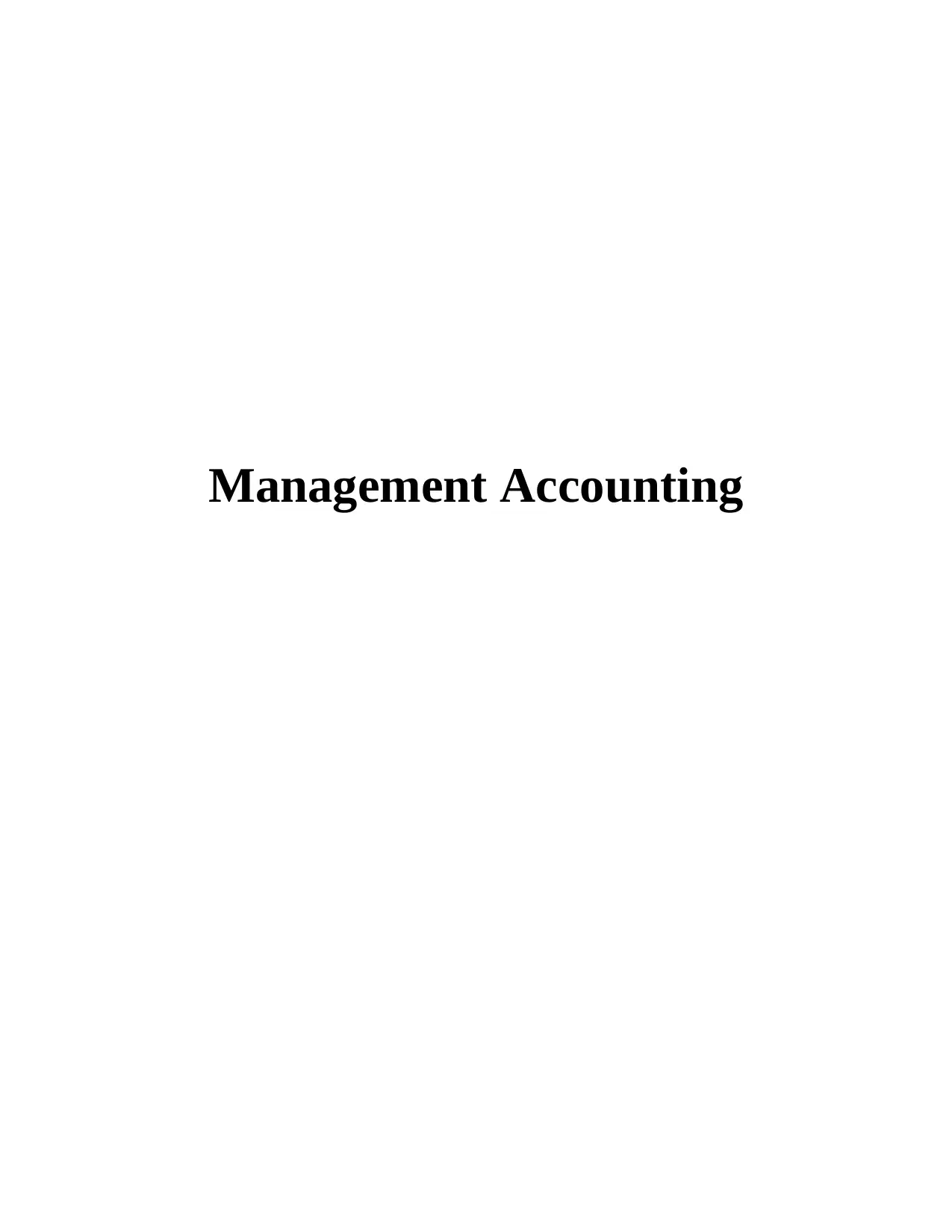
Management Accounting
Paraphrase This Document
Need a fresh take? Get an instant paraphrase of this document with our AI Paraphraser
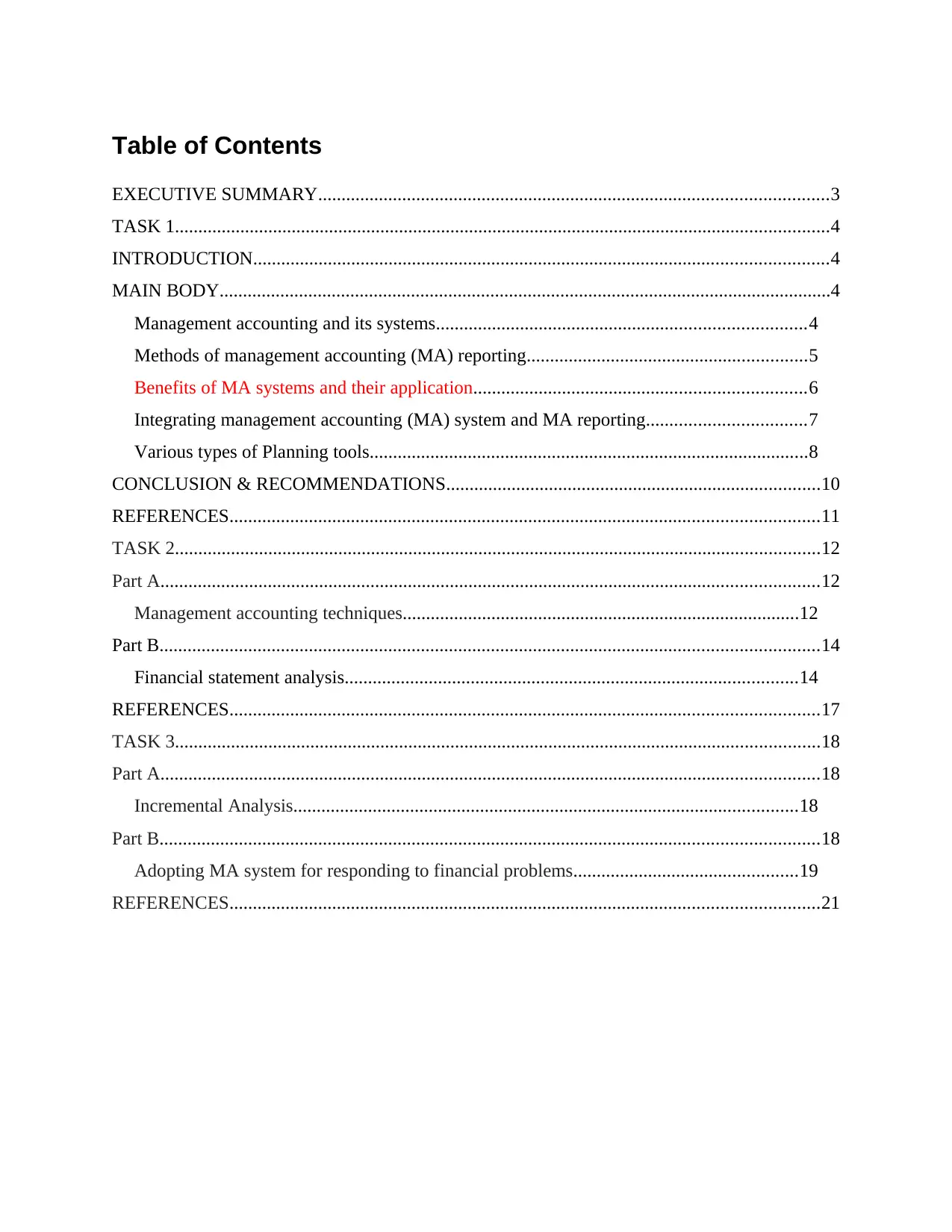
Table of Contents
EXECUTIVE SUMMARY.............................................................................................................3
TASK 1............................................................................................................................................4
INTRODUCTION...........................................................................................................................4
MAIN BODY...................................................................................................................................4
Management accounting and its systems...............................................................................4
Methods of management accounting (MA) reporting............................................................5
Benefits of MA systems and their application.......................................................................6
Integrating management accounting (MA) system and MA reporting..................................7
Various types of Planning tools..............................................................................................8
CONCLUSION & RECOMMENDATIONS................................................................................10
REFERENCES..............................................................................................................................11
TASK 2..........................................................................................................................................12
Part A.............................................................................................................................................12
Management accounting techniques.....................................................................................12
Part B.............................................................................................................................................14
Financial statement analysis.................................................................................................14
REFERENCES..............................................................................................................................17
TASK 3..........................................................................................................................................18
Part A.............................................................................................................................................18
Incremental Analysis............................................................................................................18
Part B.............................................................................................................................................18
Adopting MA system for responding to financial problems................................................19
REFERENCES..............................................................................................................................21
EXECUTIVE SUMMARY.............................................................................................................3
TASK 1............................................................................................................................................4
INTRODUCTION...........................................................................................................................4
MAIN BODY...................................................................................................................................4
Management accounting and its systems...............................................................................4
Methods of management accounting (MA) reporting............................................................5
Benefits of MA systems and their application.......................................................................6
Integrating management accounting (MA) system and MA reporting..................................7
Various types of Planning tools..............................................................................................8
CONCLUSION & RECOMMENDATIONS................................................................................10
REFERENCES..............................................................................................................................11
TASK 2..........................................................................................................................................12
Part A.............................................................................................................................................12
Management accounting techniques.....................................................................................12
Part B.............................................................................................................................................14
Financial statement analysis.................................................................................................14
REFERENCES..............................................................................................................................17
TASK 3..........................................................................................................................................18
Part A.............................................................................................................................................18
Incremental Analysis............................................................................................................18
Part B.............................................................................................................................................18
Adopting MA system for responding to financial problems................................................19
REFERENCES..............................................................................................................................21
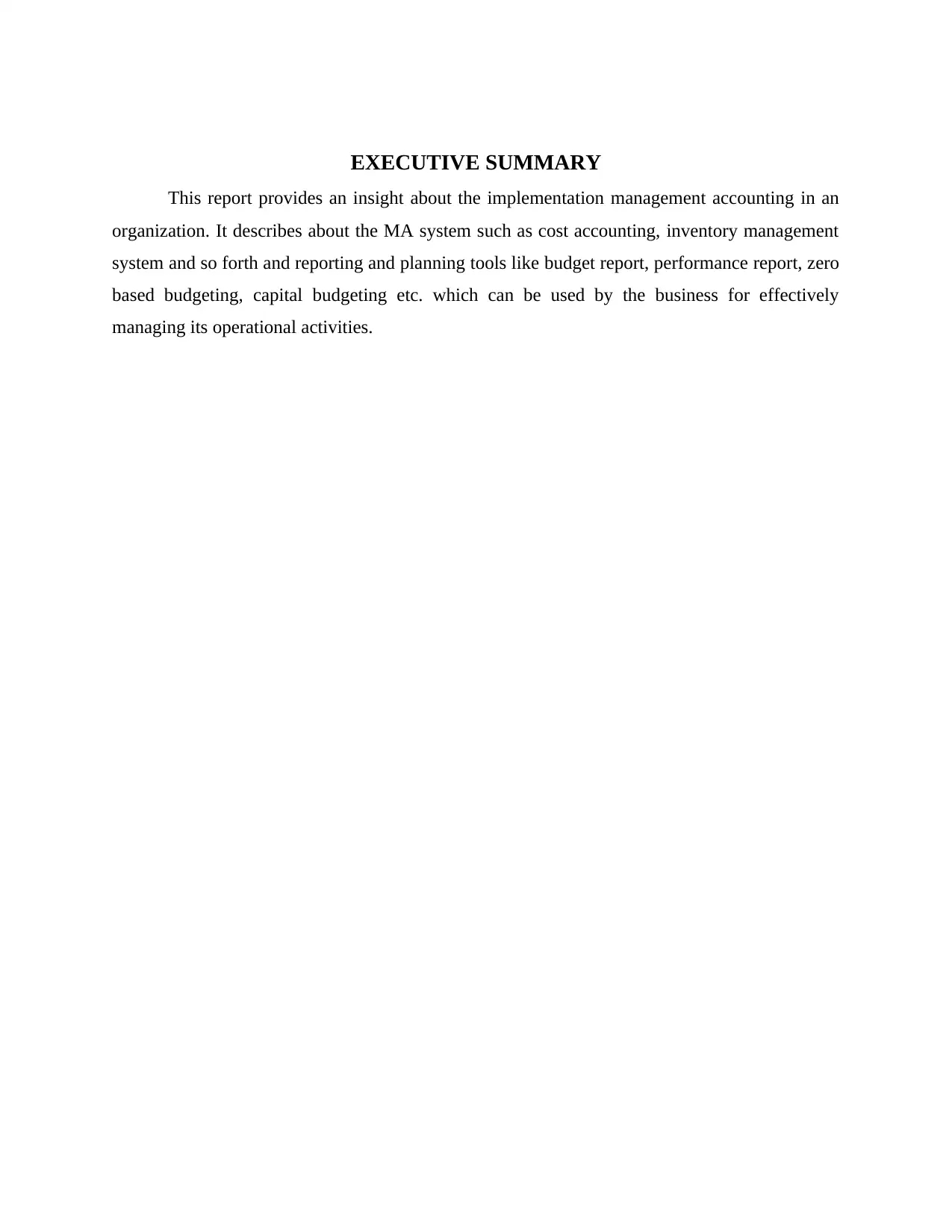
EXECUTIVE SUMMARY
This report provides an insight about the implementation management accounting in an
organization. It describes about the MA system such as cost accounting, inventory management
system and so forth and reporting and planning tools like budget report, performance report, zero
based budgeting, capital budgeting etc. which can be used by the business for effectively
managing its operational activities.
This report provides an insight about the implementation management accounting in an
organization. It describes about the MA system such as cost accounting, inventory management
system and so forth and reporting and planning tools like budget report, performance report, zero
based budgeting, capital budgeting etc. which can be used by the business for effectively
managing its operational activities.
⊘ This is a preview!⊘
Do you want full access?
Subscribe today to unlock all pages.

Trusted by 1+ million students worldwide
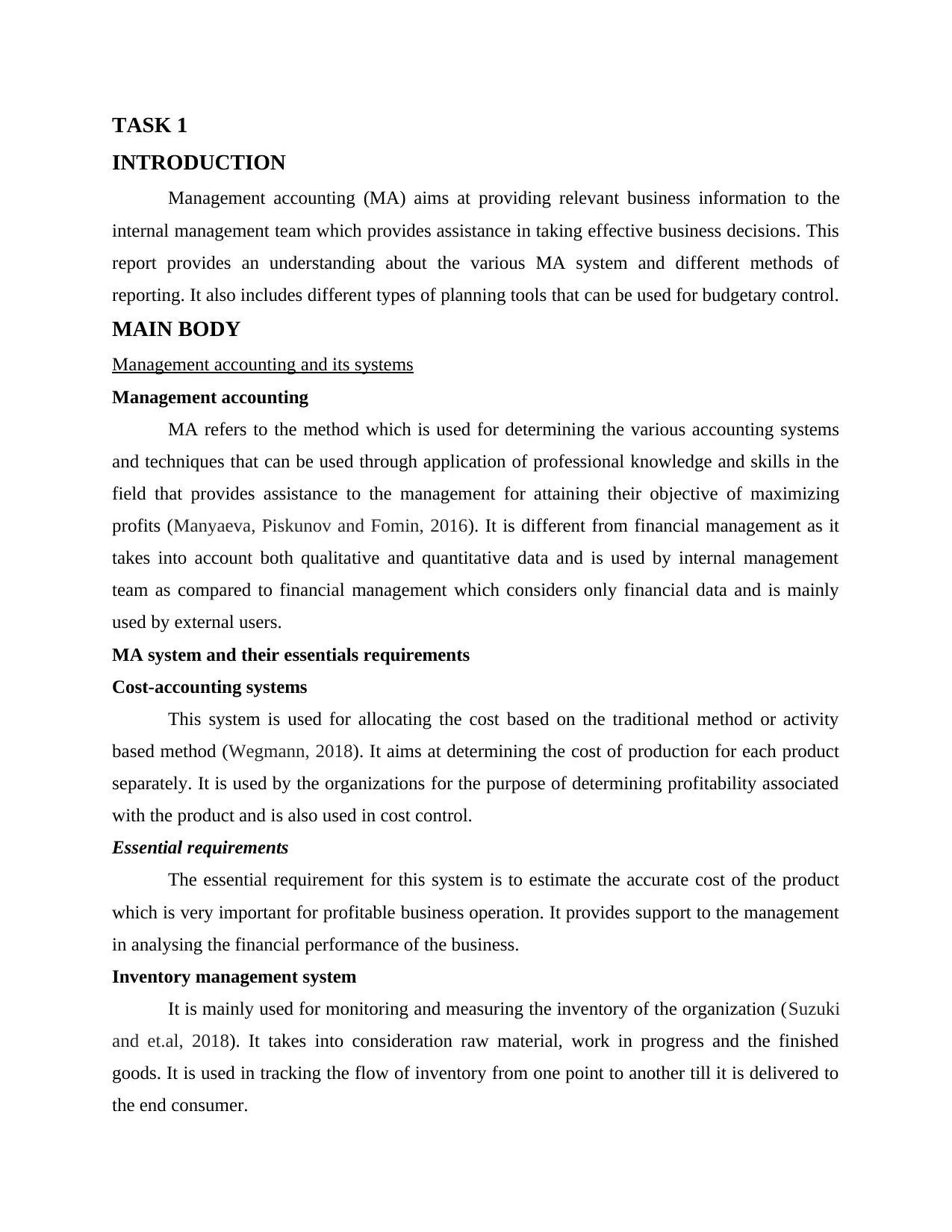
TASK 1
INTRODUCTION
Management accounting (MA) aims at providing relevant business information to the
internal management team which provides assistance in taking effective business decisions. This
report provides an understanding about the various MA system and different methods of
reporting. It also includes different types of planning tools that can be used for budgetary control.
MAIN BODY
Management accounting and its systems
Management accounting
MA refers to the method which is used for determining the various accounting systems
and techniques that can be used through application of professional knowledge and skills in the
field that provides assistance to the management for attaining their objective of maximizing
profits (Manyaeva, Piskunov and Fomin, 2016). It is different from financial management as it
takes into account both qualitative and quantitative data and is used by internal management
team as compared to financial management which considers only financial data and is mainly
used by external users.
MA system and their essentials requirements
Cost-accounting systems
This system is used for allocating the cost based on the traditional method or activity
based method (Wegmann, 2018). It aims at determining the cost of production for each product
separately. It is used by the organizations for the purpose of determining profitability associated
with the product and is also used in cost control.
Essential requirements
The essential requirement for this system is to estimate the accurate cost of the product
which is very important for profitable business operation. It provides support to the management
in analysing the financial performance of the business.
Inventory management system
It is mainly used for monitoring and measuring the inventory of the organization (Suzuki
and et.al, 2018). It takes into consideration raw material, work in progress and the finished
goods. It is used in tracking the flow of inventory from one point to another till it is delivered to
the end consumer.
INTRODUCTION
Management accounting (MA) aims at providing relevant business information to the
internal management team which provides assistance in taking effective business decisions. This
report provides an understanding about the various MA system and different methods of
reporting. It also includes different types of planning tools that can be used for budgetary control.
MAIN BODY
Management accounting and its systems
Management accounting
MA refers to the method which is used for determining the various accounting systems
and techniques that can be used through application of professional knowledge and skills in the
field that provides assistance to the management for attaining their objective of maximizing
profits (Manyaeva, Piskunov and Fomin, 2016). It is different from financial management as it
takes into account both qualitative and quantitative data and is used by internal management
team as compared to financial management which considers only financial data and is mainly
used by external users.
MA system and their essentials requirements
Cost-accounting systems
This system is used for allocating the cost based on the traditional method or activity
based method (Wegmann, 2018). It aims at determining the cost of production for each product
separately. It is used by the organizations for the purpose of determining profitability associated
with the product and is also used in cost control.
Essential requirements
The essential requirement for this system is to estimate the accurate cost of the product
which is very important for profitable business operation. It provides support to the management
in analysing the financial performance of the business.
Inventory management system
It is mainly used for monitoring and measuring the inventory of the organization (Suzuki
and et.al, 2018). It takes into consideration raw material, work in progress and the finished
goods. It is used in tracking the flow of inventory from one point to another till it is delivered to
the end consumer.
Paraphrase This Document
Need a fresh take? Get an instant paraphrase of this document with our AI Paraphraser
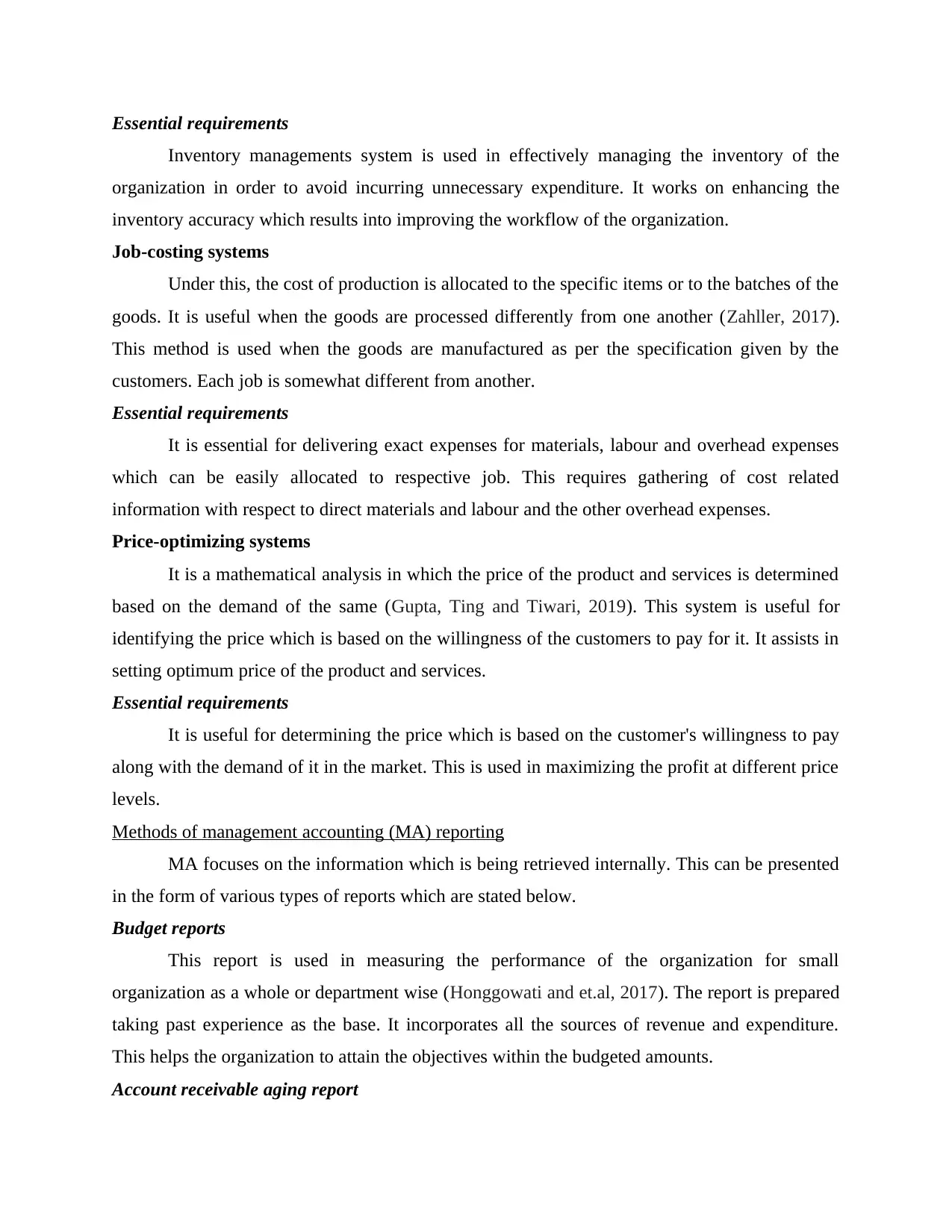
Essential requirements
Inventory managements system is used in effectively managing the inventory of the
organization in order to avoid incurring unnecessary expenditure. It works on enhancing the
inventory accuracy which results into improving the workflow of the organization.
Job-costing systems
Under this, the cost of production is allocated to the specific items or to the batches of the
goods. It is useful when the goods are processed differently from one another (Zahller, 2017).
This method is used when the goods are manufactured as per the specification given by the
customers. Each job is somewhat different from another.
Essential requirements
It is essential for delivering exact expenses for materials, labour and overhead expenses
which can be easily allocated to respective job. This requires gathering of cost related
information with respect to direct materials and labour and the other overhead expenses.
Price-optimizing systems
It is a mathematical analysis in which the price of the product and services is determined
based on the demand of the same (Gupta, Ting and Tiwari, 2019). This system is useful for
identifying the price which is based on the willingness of the customers to pay for it. It assists in
setting optimum price of the product and services.
Essential requirements
It is useful for determining the price which is based on the customer's willingness to pay
along with the demand of it in the market. This is used in maximizing the profit at different price
levels.
Methods of management accounting (MA) reporting
MA focuses on the information which is being retrieved internally. This can be presented
in the form of various types of reports which are stated below.
Budget reports
This report is used in measuring the performance of the organization for small
organization as a whole or department wise (Honggowati and et.al, 2017). The report is prepared
taking past experience as the base. It incorporates all the sources of revenue and expenditure.
This helps the organization to attain the objectives within the budgeted amounts.
Account receivable aging report
Inventory managements system is used in effectively managing the inventory of the
organization in order to avoid incurring unnecessary expenditure. It works on enhancing the
inventory accuracy which results into improving the workflow of the organization.
Job-costing systems
Under this, the cost of production is allocated to the specific items or to the batches of the
goods. It is useful when the goods are processed differently from one another (Zahller, 2017).
This method is used when the goods are manufactured as per the specification given by the
customers. Each job is somewhat different from another.
Essential requirements
It is essential for delivering exact expenses for materials, labour and overhead expenses
which can be easily allocated to respective job. This requires gathering of cost related
information with respect to direct materials and labour and the other overhead expenses.
Price-optimizing systems
It is a mathematical analysis in which the price of the product and services is determined
based on the demand of the same (Gupta, Ting and Tiwari, 2019). This system is useful for
identifying the price which is based on the willingness of the customers to pay for it. It assists in
setting optimum price of the product and services.
Essential requirements
It is useful for determining the price which is based on the customer's willingness to pay
along with the demand of it in the market. This is used in maximizing the profit at different price
levels.
Methods of management accounting (MA) reporting
MA focuses on the information which is being retrieved internally. This can be presented
in the form of various types of reports which are stated below.
Budget reports
This report is used in measuring the performance of the organization for small
organization as a whole or department wise (Honggowati and et.al, 2017). The report is prepared
taking past experience as the base. It incorporates all the sources of revenue and expenditure.
This helps the organization to attain the objectives within the budgeted amounts.
Account receivable aging report
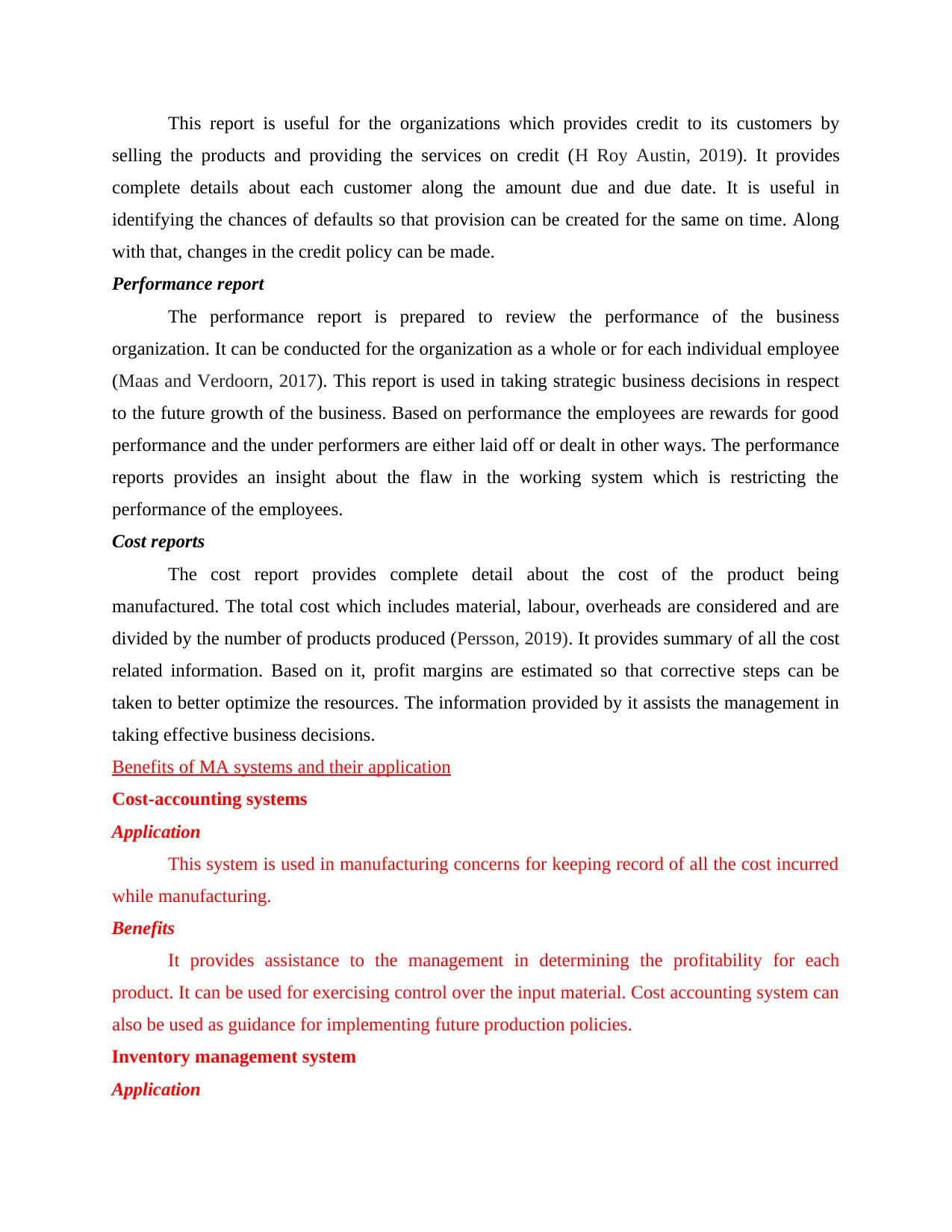
This report is useful for the organizations which provides credit to its customers by
selling the products and providing the services on credit (H Roy Austin, 2019). It provides
complete details about each customer along the amount due and due date. It is useful in
identifying the chances of defaults so that provision can be created for the same on time. Along
with that, changes in the credit policy can be made.
Performance report
The performance report is prepared to review the performance of the business
organization. It can be conducted for the organization as a whole or for each individual employee
(Maas and Verdoorn, 2017). This report is used in taking strategic business decisions in respect
to the future growth of the business. Based on performance the employees are rewards for good
performance and the under performers are either laid off or dealt in other ways. The performance
reports provides an insight about the flaw in the working system which is restricting the
performance of the employees.
Cost reports
The cost report provides complete detail about the cost of the product being
manufactured. The total cost which includes material, labour, overheads are considered and are
divided by the number of products produced (Persson, 2019). It provides summary of all the cost
related information. Based on it, profit margins are estimated so that corrective steps can be
taken to better optimize the resources. The information provided by it assists the management in
taking effective business decisions.
Benefits of MA systems and their application
Cost-accounting systems
Application
This system is used in manufacturing concerns for keeping record of all the cost incurred
while manufacturing.
Benefits
It provides assistance to the management in determining the profitability for each
product. It can be used for exercising control over the input material. Cost accounting system can
also be used as guidance for implementing future production policies.
Inventory management system
Application
selling the products and providing the services on credit (H Roy Austin, 2019). It provides
complete details about each customer along the amount due and due date. It is useful in
identifying the chances of defaults so that provision can be created for the same on time. Along
with that, changes in the credit policy can be made.
Performance report
The performance report is prepared to review the performance of the business
organization. It can be conducted for the organization as a whole or for each individual employee
(Maas and Verdoorn, 2017). This report is used in taking strategic business decisions in respect
to the future growth of the business. Based on performance the employees are rewards for good
performance and the under performers are either laid off or dealt in other ways. The performance
reports provides an insight about the flaw in the working system which is restricting the
performance of the employees.
Cost reports
The cost report provides complete detail about the cost of the product being
manufactured. The total cost which includes material, labour, overheads are considered and are
divided by the number of products produced (Persson, 2019). It provides summary of all the cost
related information. Based on it, profit margins are estimated so that corrective steps can be
taken to better optimize the resources. The information provided by it assists the management in
taking effective business decisions.
Benefits of MA systems and their application
Cost-accounting systems
Application
This system is used in manufacturing concerns for keeping record of all the cost incurred
while manufacturing.
Benefits
It provides assistance to the management in determining the profitability for each
product. It can be used for exercising control over the input material. Cost accounting system can
also be used as guidance for implementing future production policies.
Inventory management system
Application
⊘ This is a preview!⊘
Do you want full access?
Subscribe today to unlock all pages.

Trusted by 1+ million students worldwide
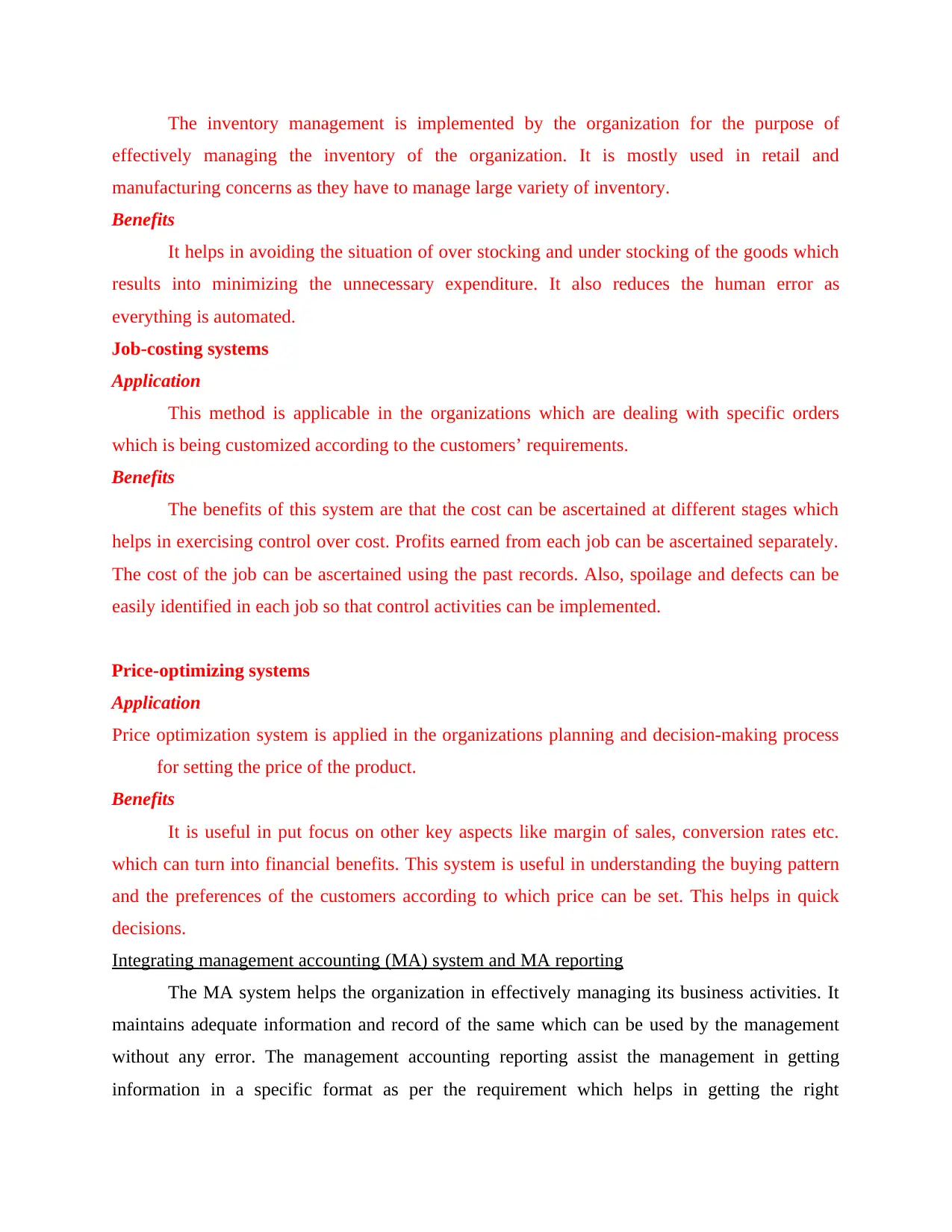
The inventory management is implemented by the organization for the purpose of
effectively managing the inventory of the organization. It is mostly used in retail and
manufacturing concerns as they have to manage large variety of inventory.
Benefits
It helps in avoiding the situation of over stocking and under stocking of the goods which
results into minimizing the unnecessary expenditure. It also reduces the human error as
everything is automated.
Job-costing systems
Application
This method is applicable in the organizations which are dealing with specific orders
which is being customized according to the customers’ requirements.
Benefits
The benefits of this system are that the cost can be ascertained at different stages which
helps in exercising control over cost. Profits earned from each job can be ascertained separately.
The cost of the job can be ascertained using the past records. Also, spoilage and defects can be
easily identified in each job so that control activities can be implemented.
Price-optimizing systems
Application
Price optimization system is applied in the organizations planning and decision-making process
for setting the price of the product.
Benefits
It is useful in put focus on other key aspects like margin of sales, conversion rates etc.
which can turn into financial benefits. This system is useful in understanding the buying pattern
and the preferences of the customers according to which price can be set. This helps in quick
decisions.
Integrating management accounting (MA) system and MA reporting
The MA system helps the organization in effectively managing its business activities. It
maintains adequate information and record of the same which can be used by the management
without any error. The management accounting reporting assist the management in getting
information in a specific format as per the requirement which helps in getting the right
effectively managing the inventory of the organization. It is mostly used in retail and
manufacturing concerns as they have to manage large variety of inventory.
Benefits
It helps in avoiding the situation of over stocking and under stocking of the goods which
results into minimizing the unnecessary expenditure. It also reduces the human error as
everything is automated.
Job-costing systems
Application
This method is applicable in the organizations which are dealing with specific orders
which is being customized according to the customers’ requirements.
Benefits
The benefits of this system are that the cost can be ascertained at different stages which
helps in exercising control over cost. Profits earned from each job can be ascertained separately.
The cost of the job can be ascertained using the past records. Also, spoilage and defects can be
easily identified in each job so that control activities can be implemented.
Price-optimizing systems
Application
Price optimization system is applied in the organizations planning and decision-making process
for setting the price of the product.
Benefits
It is useful in put focus on other key aspects like margin of sales, conversion rates etc.
which can turn into financial benefits. This system is useful in understanding the buying pattern
and the preferences of the customers according to which price can be set. This helps in quick
decisions.
Integrating management accounting (MA) system and MA reporting
The MA system helps the organization in effectively managing its business activities. It
maintains adequate information and record of the same which can be used by the management
without any error. The management accounting reporting assist the management in getting
information in a specific format as per the requirement which helps in getting the right
Paraphrase This Document
Need a fresh take? Get an instant paraphrase of this document with our AI Paraphraser
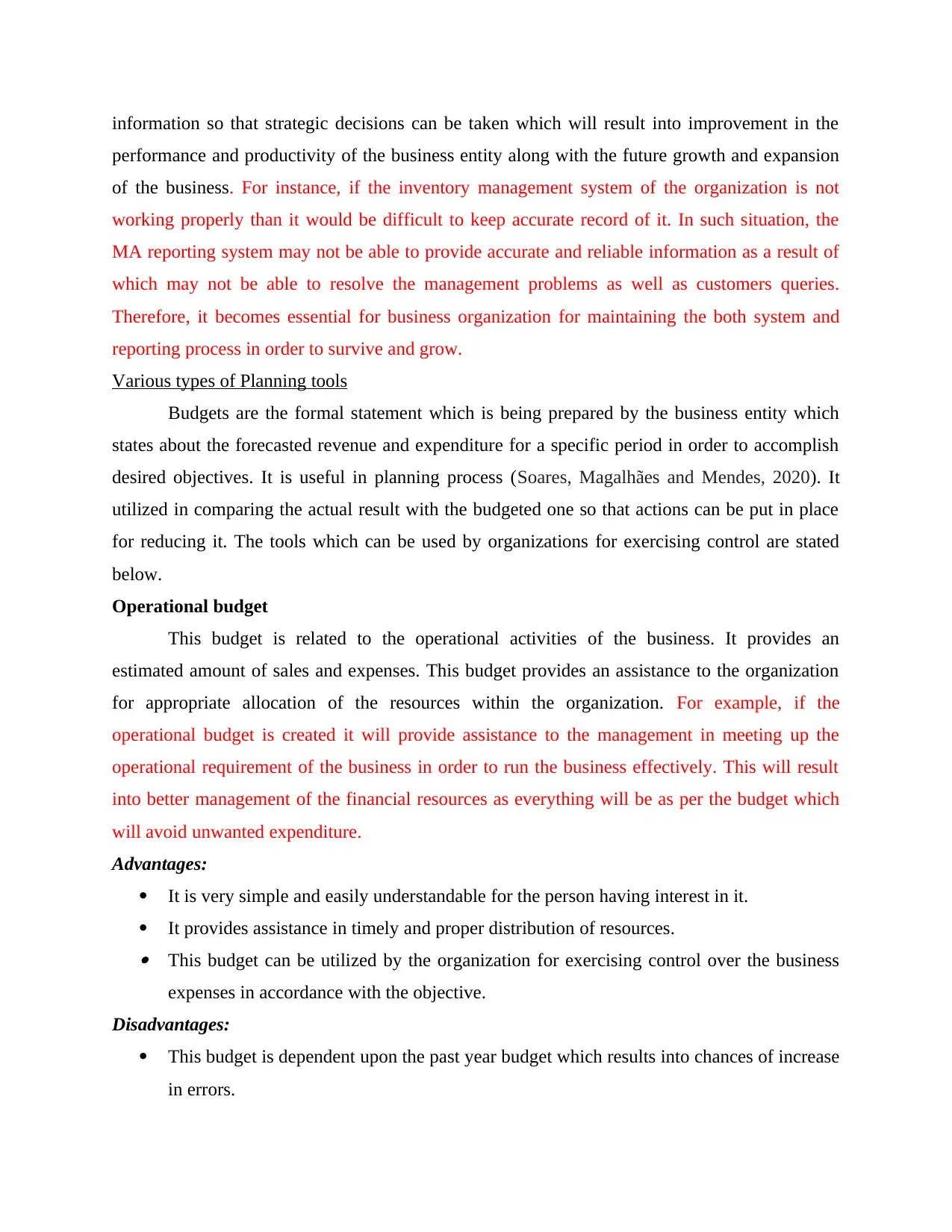
information so that strategic decisions can be taken which will result into improvement in the
performance and productivity of the business entity along with the future growth and expansion
of the business. For instance, if the inventory management system of the organization is not
working properly than it would be difficult to keep accurate record of it. In such situation, the
MA reporting system may not be able to provide accurate and reliable information as a result of
which may not be able to resolve the management problems as well as customers queries.
Therefore, it becomes essential for business organization for maintaining the both system and
reporting process in order to survive and grow.
Various types of Planning tools
Budgets are the formal statement which is being prepared by the business entity which
states about the forecasted revenue and expenditure for a specific period in order to accomplish
desired objectives. It is useful in planning process (Soares, Magalhães and Mendes, 2020). It
utilized in comparing the actual result with the budgeted one so that actions can be put in place
for reducing it. The tools which can be used by organizations for exercising control are stated
below.
Operational budget
This budget is related to the operational activities of the business. It provides an
estimated amount of sales and expenses. This budget provides an assistance to the organization
for appropriate allocation of the resources within the organization. For example, if the
operational budget is created it will provide assistance to the management in meeting up the
operational requirement of the business in order to run the business effectively. This will result
into better management of the financial resources as everything will be as per the budget which
will avoid unwanted expenditure.
Advantages:
It is very simple and easily understandable for the person having interest in it.
It provides assistance in timely and proper distribution of resources. This budget can be utilized by the organization for exercising control over the business
expenses in accordance with the objective.
Disadvantages:
This budget is dependent upon the past year budget which results into chances of increase
in errors.
performance and productivity of the business entity along with the future growth and expansion
of the business. For instance, if the inventory management system of the organization is not
working properly than it would be difficult to keep accurate record of it. In such situation, the
MA reporting system may not be able to provide accurate and reliable information as a result of
which may not be able to resolve the management problems as well as customers queries.
Therefore, it becomes essential for business organization for maintaining the both system and
reporting process in order to survive and grow.
Various types of Planning tools
Budgets are the formal statement which is being prepared by the business entity which
states about the forecasted revenue and expenditure for a specific period in order to accomplish
desired objectives. It is useful in planning process (Soares, Magalhães and Mendes, 2020). It
utilized in comparing the actual result with the budgeted one so that actions can be put in place
for reducing it. The tools which can be used by organizations for exercising control are stated
below.
Operational budget
This budget is related to the operational activities of the business. It provides an
estimated amount of sales and expenses. This budget provides an assistance to the organization
for appropriate allocation of the resources within the organization. For example, if the
operational budget is created it will provide assistance to the management in meeting up the
operational requirement of the business in order to run the business effectively. This will result
into better management of the financial resources as everything will be as per the budget which
will avoid unwanted expenditure.
Advantages:
It is very simple and easily understandable for the person having interest in it.
It provides assistance in timely and proper distribution of resources. This budget can be utilized by the organization for exercising control over the business
expenses in accordance with the objective.
Disadvantages:
This budget is dependent upon the past year budget which results into chances of increase
in errors.
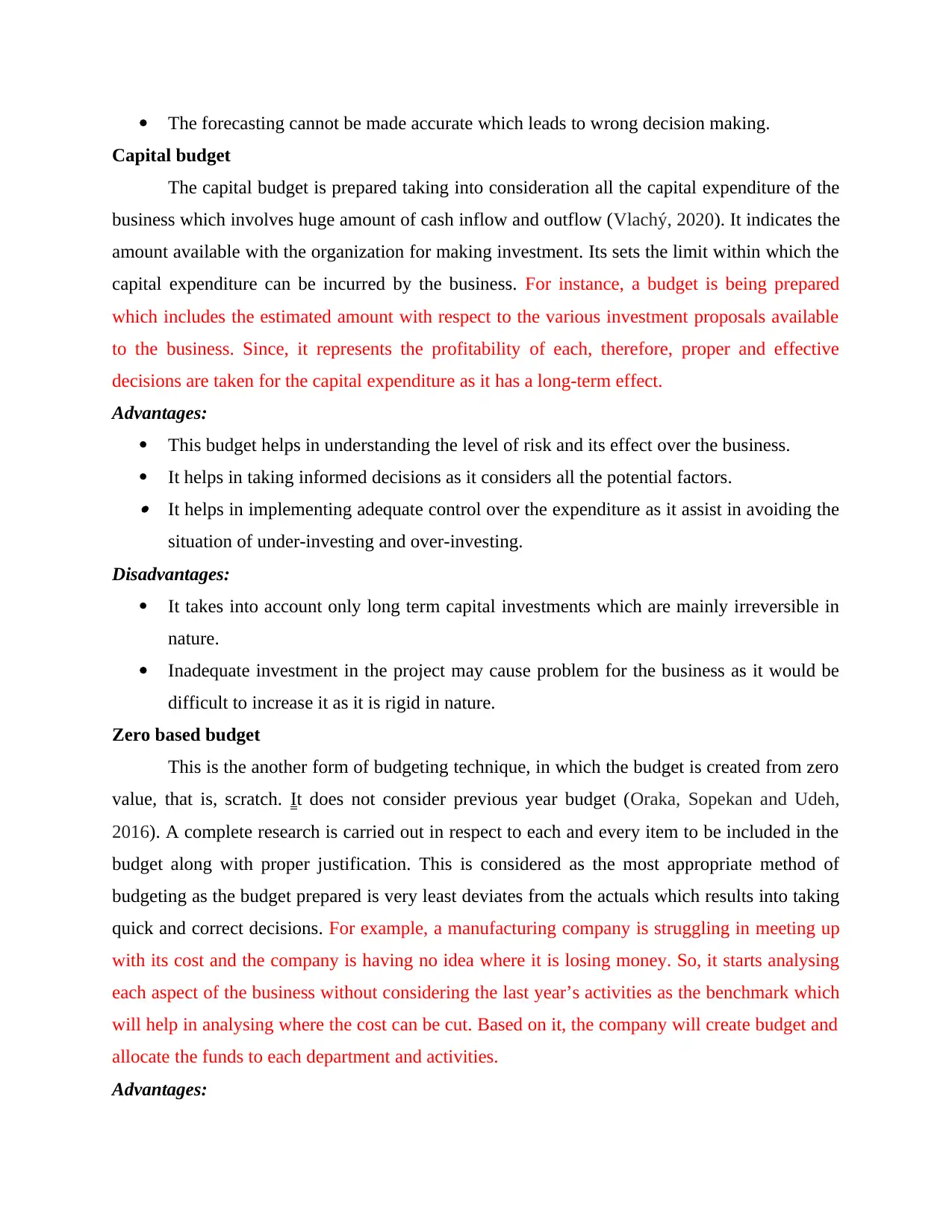
The forecasting cannot be made accurate which leads to wrong decision making.
Capital budget
The capital budget is prepared taking into consideration all the capital expenditure of the
business which involves huge amount of cash inflow and outflow (Vlachý, 2020). It indicates the
amount available with the organization for making investment. Its sets the limit within which the
capital expenditure can be incurred by the business. For instance, a budget is being prepared
which includes the estimated amount with respect to the various investment proposals available
to the business. Since, it represents the profitability of each, therefore, proper and effective
decisions are taken for the capital expenditure as it has a long-term effect.
Advantages:
This budget helps in understanding the level of risk and its effect over the business.
It helps in taking informed decisions as it considers all the potential factors. It helps in implementing adequate control over the expenditure as it assist in avoiding the
situation of under-investing and over-investing.
Disadvantages:
It takes into account only long term capital investments which are mainly irreversible in
nature.
Inadequate investment in the project may cause problem for the business as it would be
difficult to increase it as it is rigid in nature.
Zero based budget
This is the another form of budgeting technique, in which the budget is created from zero
value, that is, scratch. It does not consider previous year budget (Oraka, Sopekan and Udeh,
2016). A complete research is carried out in respect to each and every item to be included in the
budget along with proper justification. This is considered as the most appropriate method of
budgeting as the budget prepared is very least deviates from the actuals which results into taking
quick and correct decisions. For example, a manufacturing company is struggling in meeting up
with its cost and the company is having no idea where it is losing money. So, it starts analysing
each aspect of the business without considering the last year’s activities as the benchmark which
will help in analysing where the cost can be cut. Based on it, the company will create budget and
allocate the funds to each department and activities.
Advantages:
Capital budget
The capital budget is prepared taking into consideration all the capital expenditure of the
business which involves huge amount of cash inflow and outflow (Vlachý, 2020). It indicates the
amount available with the organization for making investment. Its sets the limit within which the
capital expenditure can be incurred by the business. For instance, a budget is being prepared
which includes the estimated amount with respect to the various investment proposals available
to the business. Since, it represents the profitability of each, therefore, proper and effective
decisions are taken for the capital expenditure as it has a long-term effect.
Advantages:
This budget helps in understanding the level of risk and its effect over the business.
It helps in taking informed decisions as it considers all the potential factors. It helps in implementing adequate control over the expenditure as it assist in avoiding the
situation of under-investing and over-investing.
Disadvantages:
It takes into account only long term capital investments which are mainly irreversible in
nature.
Inadequate investment in the project may cause problem for the business as it would be
difficult to increase it as it is rigid in nature.
Zero based budget
This is the another form of budgeting technique, in which the budget is created from zero
value, that is, scratch. It does not consider previous year budget (Oraka, Sopekan and Udeh,
2016). A complete research is carried out in respect to each and every item to be included in the
budget along with proper justification. This is considered as the most appropriate method of
budgeting as the budget prepared is very least deviates from the actuals which results into taking
quick and correct decisions. For example, a manufacturing company is struggling in meeting up
with its cost and the company is having no idea where it is losing money. So, it starts analysing
each aspect of the business without considering the last year’s activities as the benchmark which
will help in analysing where the cost can be cut. Based on it, the company will create budget and
allocate the funds to each department and activities.
Advantages:
⊘ This is a preview!⊘
Do you want full access?
Subscribe today to unlock all pages.

Trusted by 1+ million students worldwide
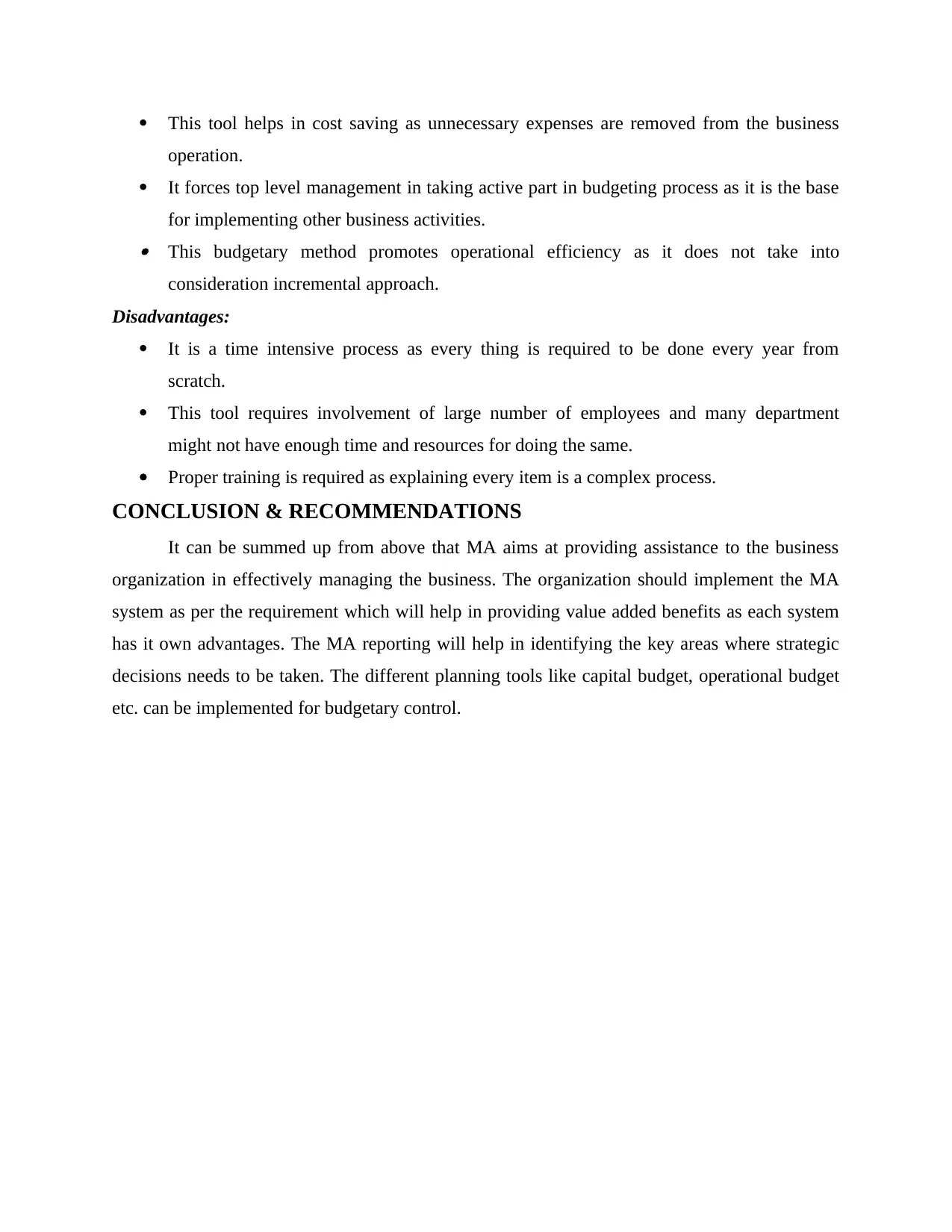
This tool helps in cost saving as unnecessary expenses are removed from the business
operation.
It forces top level management in taking active part in budgeting process as it is the base
for implementing other business activities. This budgetary method promotes operational efficiency as it does not take into
consideration incremental approach.
Disadvantages:
It is a time intensive process as every thing is required to be done every year from
scratch.
This tool requires involvement of large number of employees and many department
might not have enough time and resources for doing the same.
Proper training is required as explaining every item is a complex process.
CONCLUSION & RECOMMENDATIONS
It can be summed up from above that MA aims at providing assistance to the business
organization in effectively managing the business. The organization should implement the MA
system as per the requirement which will help in providing value added benefits as each system
has it own advantages. The MA reporting will help in identifying the key areas where strategic
decisions needs to be taken. The different planning tools like capital budget, operational budget
etc. can be implemented for budgetary control.
operation.
It forces top level management in taking active part in budgeting process as it is the base
for implementing other business activities. This budgetary method promotes operational efficiency as it does not take into
consideration incremental approach.
Disadvantages:
It is a time intensive process as every thing is required to be done every year from
scratch.
This tool requires involvement of large number of employees and many department
might not have enough time and resources for doing the same.
Proper training is required as explaining every item is a complex process.
CONCLUSION & RECOMMENDATIONS
It can be summed up from above that MA aims at providing assistance to the business
organization in effectively managing the business. The organization should implement the MA
system as per the requirement which will help in providing value added benefits as each system
has it own advantages. The MA reporting will help in identifying the key areas where strategic
decisions needs to be taken. The different planning tools like capital budget, operational budget
etc. can be implemented for budgetary control.
Paraphrase This Document
Need a fresh take? Get an instant paraphrase of this document with our AI Paraphraser
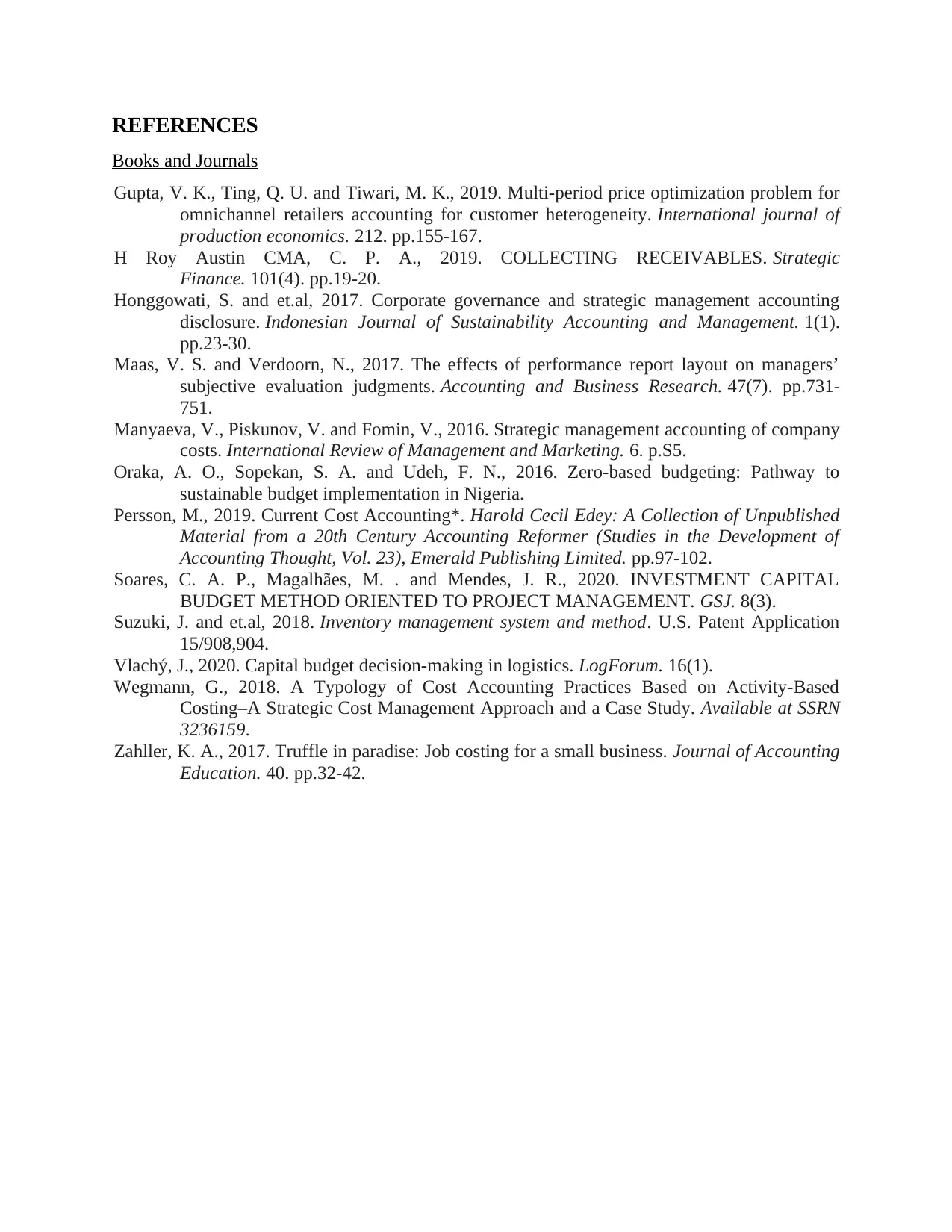
REFERENCES
Books and Journals
Gupta, V. K., Ting, Q. U. and Tiwari, M. K., 2019. Multi-period price optimization problem for
omnichannel retailers accounting for customer heterogeneity. International journal of
production economics. 212. pp.155-167.
H Roy Austin CMA, C. P. A., 2019. COLLECTING RECEIVABLES. Strategic
Finance. 101(4). pp.19-20.
Honggowati, S. and et.al, 2017. Corporate governance and strategic management accounting
disclosure. Indonesian Journal of Sustainability Accounting and Management. 1(1).
pp.23-30.
Maas, V. S. and Verdoorn, N., 2017. The effects of performance report layout on managers’
subjective evaluation judgments. Accounting and Business Research. 47(7). pp.731-
751.
Manyaeva, V., Piskunov, V. and Fomin, V., 2016. Strategic management accounting of company
costs. International Review of Management and Marketing. 6. p.S5.
Oraka, A. O., Sopekan, S. A. and Udeh, F. N., 2016. Zero-based budgeting: Pathway to
sustainable budget implementation in Nigeria.
Persson, M., 2019. Current Cost Accounting*. Harold Cecil Edey: A Collection of Unpublished
Material from a 20th Century Accounting Reformer (Studies in the Development of
Accounting Thought, Vol. 23), Emerald Publishing Limited. pp.97-102.
Soares, C. A. P., Magalhães, M. . and Mendes, J. R., 2020. INVESTMENT CAPITAL
BUDGET METHOD ORIENTED TO PROJECT MANAGEMENT. GSJ. 8(3).
Suzuki, J. and et.al, 2018. Inventory management system and method. U.S. Patent Application
15/908,904.
Vlachý, J., 2020. Capital budget decision-making in logistics. LogForum. 16(1).
Wegmann, G., 2018. A Typology of Cost Accounting Practices Based on Activity-Based
Costing–A Strategic Cost Management Approach and a Case Study. Available at SSRN
3236159.
Zahller, K. A., 2017. Truffle in paradise: Job costing for a small business. Journal of Accounting
Education. 40. pp.32-42.
Books and Journals
Gupta, V. K., Ting, Q. U. and Tiwari, M. K., 2019. Multi-period price optimization problem for
omnichannel retailers accounting for customer heterogeneity. International journal of
production economics. 212. pp.155-167.
H Roy Austin CMA, C. P. A., 2019. COLLECTING RECEIVABLES. Strategic
Finance. 101(4). pp.19-20.
Honggowati, S. and et.al, 2017. Corporate governance and strategic management accounting
disclosure. Indonesian Journal of Sustainability Accounting and Management. 1(1).
pp.23-30.
Maas, V. S. and Verdoorn, N., 2017. The effects of performance report layout on managers’
subjective evaluation judgments. Accounting and Business Research. 47(7). pp.731-
751.
Manyaeva, V., Piskunov, V. and Fomin, V., 2016. Strategic management accounting of company
costs. International Review of Management and Marketing. 6. p.S5.
Oraka, A. O., Sopekan, S. A. and Udeh, F. N., 2016. Zero-based budgeting: Pathway to
sustainable budget implementation in Nigeria.
Persson, M., 2019. Current Cost Accounting*. Harold Cecil Edey: A Collection of Unpublished
Material from a 20th Century Accounting Reformer (Studies in the Development of
Accounting Thought, Vol. 23), Emerald Publishing Limited. pp.97-102.
Soares, C. A. P., Magalhães, M. . and Mendes, J. R., 2020. INVESTMENT CAPITAL
BUDGET METHOD ORIENTED TO PROJECT MANAGEMENT. GSJ. 8(3).
Suzuki, J. and et.al, 2018. Inventory management system and method. U.S. Patent Application
15/908,904.
Vlachý, J., 2020. Capital budget decision-making in logistics. LogForum. 16(1).
Wegmann, G., 2018. A Typology of Cost Accounting Practices Based on Activity-Based
Costing–A Strategic Cost Management Approach and a Case Study. Available at SSRN
3236159.
Zahller, K. A., 2017. Truffle in paradise: Job costing for a small business. Journal of Accounting
Education. 40. pp.32-42.
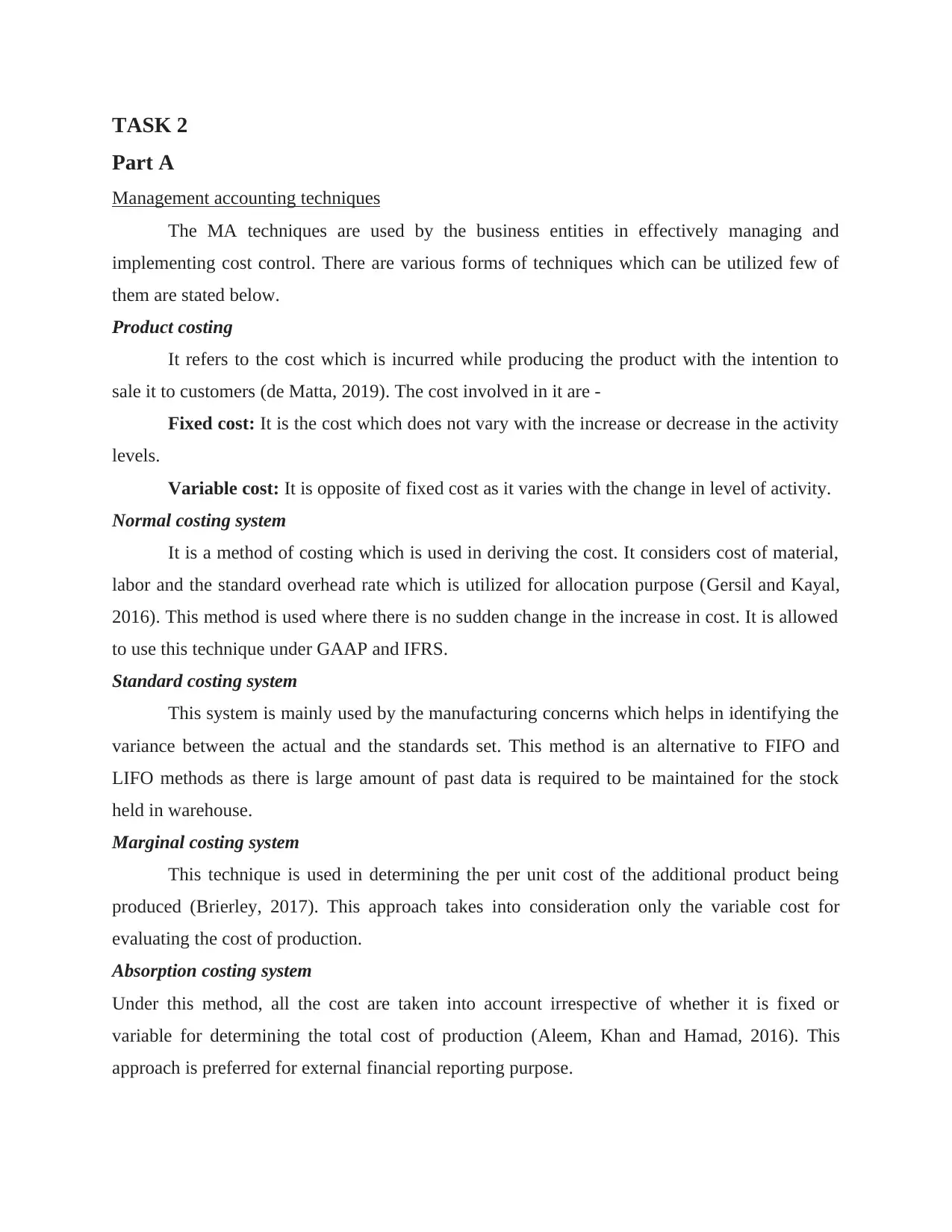
TASK 2
Part A
Management accounting techniques
The MA techniques are used by the business entities in effectively managing and
implementing cost control. There are various forms of techniques which can be utilized few of
them are stated below.
Product costing
It refers to the cost which is incurred while producing the product with the intention to
sale it to customers (de Matta, 2019). The cost involved in it are -
Fixed cost: It is the cost which does not vary with the increase or decrease in the activity
levels.
Variable cost: It is opposite of fixed cost as it varies with the change in level of activity.
Normal costing system
It is a method of costing which is used in deriving the cost. It considers cost of material,
labor and the standard overhead rate which is utilized for allocation purpose (Gersil and Kayal,
2016). This method is used where there is no sudden change in the increase in cost. It is allowed
to use this technique under GAAP and IFRS.
Standard costing system
This system is mainly used by the manufacturing concerns which helps in identifying the
variance between the actual and the standards set. This method is an alternative to FIFO and
LIFO methods as there is large amount of past data is required to be maintained for the stock
held in warehouse.
Marginal costing system
This technique is used in determining the per unit cost of the additional product being
produced (Brierley, 2017). This approach takes into consideration only the variable cost for
evaluating the cost of production.
Absorption costing system
Under this method, all the cost are taken into account irrespective of whether it is fixed or
variable for determining the total cost of production (Aleem, Khan and Hamad, 2016). This
approach is preferred for external financial reporting purpose.
Part A
Management accounting techniques
The MA techniques are used by the business entities in effectively managing and
implementing cost control. There are various forms of techniques which can be utilized few of
them are stated below.
Product costing
It refers to the cost which is incurred while producing the product with the intention to
sale it to customers (de Matta, 2019). The cost involved in it are -
Fixed cost: It is the cost which does not vary with the increase or decrease in the activity
levels.
Variable cost: It is opposite of fixed cost as it varies with the change in level of activity.
Normal costing system
It is a method of costing which is used in deriving the cost. It considers cost of material,
labor and the standard overhead rate which is utilized for allocation purpose (Gersil and Kayal,
2016). This method is used where there is no sudden change in the increase in cost. It is allowed
to use this technique under GAAP and IFRS.
Standard costing system
This system is mainly used by the manufacturing concerns which helps in identifying the
variance between the actual and the standards set. This method is an alternative to FIFO and
LIFO methods as there is large amount of past data is required to be maintained for the stock
held in warehouse.
Marginal costing system
This technique is used in determining the per unit cost of the additional product being
produced (Brierley, 2017). This approach takes into consideration only the variable cost for
evaluating the cost of production.
Absorption costing system
Under this method, all the cost are taken into account irrespective of whether it is fixed or
variable for determining the total cost of production (Aleem, Khan and Hamad, 2016). This
approach is preferred for external financial reporting purpose.
⊘ This is a preview!⊘
Do you want full access?
Subscribe today to unlock all pages.

Trusted by 1+ million students worldwide
1 out of 22
Related Documents
Your All-in-One AI-Powered Toolkit for Academic Success.
+13062052269
info@desklib.com
Available 24*7 on WhatsApp / Email
![[object Object]](/_next/static/media/star-bottom.7253800d.svg)
Unlock your academic potential
Copyright © 2020–2025 A2Z Services. All Rights Reserved. Developed and managed by ZUCOL.





